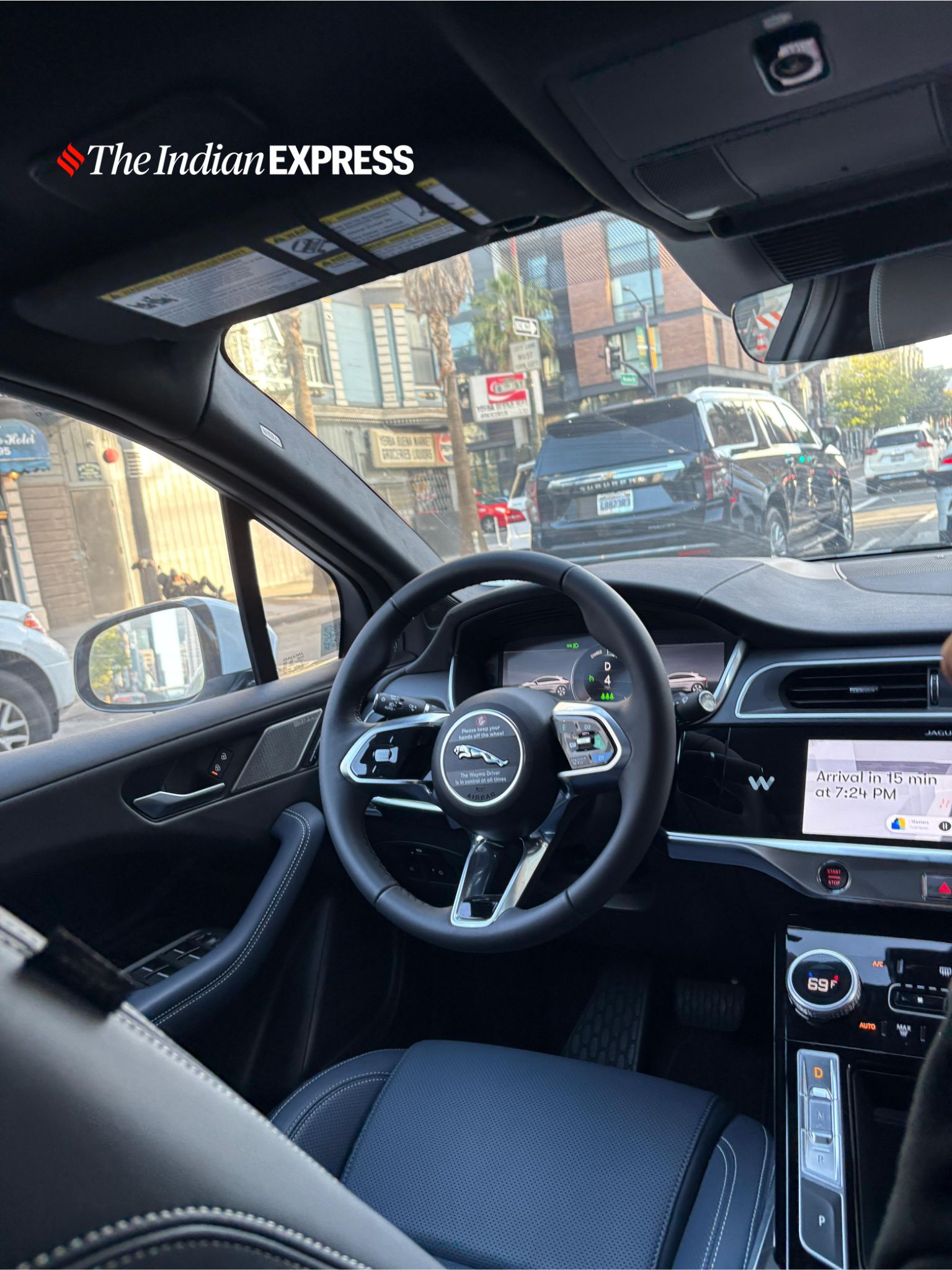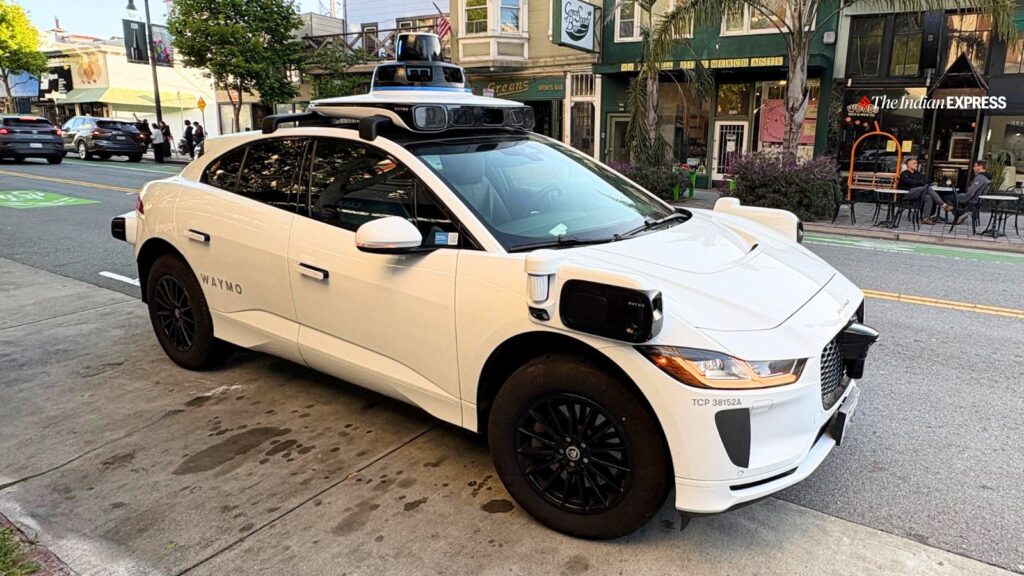A tinge of “giddiness amid childish excitement”: this is how I would describe my first-ever ride in a driverless car. Until now, I have only seen such technological marvels in Hollywood blockbusters Minority Report and I, Robot. And honestly, I never in my faintest imagination could picture myself being driven around by a robot. Ever since arriving in San Francisco, I have been eagerly waiting to hop into a Waymo robotaxi and go around town.
On a breezy June evening, after a long day with back-to-back sessions, it was finally time to unwind. Although I was unsure about the mode of transport, I was vaguely aware that there was a likelihood we would hail a Waymo. One of my team members fired up their Waymo One app, an application that resembles popular ride-hailing apps. The robotaxi was booked, and we waited by the kerb outside the hotel.
It is a Waymo, but it is also a Jaguar. Yes, the Waymos in San Francisco are Jaguar I-Pace, a battery-electric crossover by Jaguar Land Rover. Moments after spotting the car, we were inside it. The first thing I noticed was there was no one in the driver’s seat.
“The driver’s seat is off-limits, but feel free to sit in any other available seat,” reads the Waymo One rulebook. Also, Waymo One cars allow up to four passengers.
The app setup is fairly simple, and within minutes, you can look at your first ride on screen. My destination? Florella Noe, a pleasant Italian restaurant, was an outing planned by the team.

 Inside a Waymo robotaxi: The empty driver’s seat of a Jaguar I-Pace. (Image: Bijin Jose/The Indian Express)
Inside a Waymo robotaxi: The empty driver’s seat of a Jaguar I-Pace. (Image: Bijin Jose/The Indian Express)
The app, much like Uber, shows the estimated time of arrival, street maps, and rates. All this while, I kept wondering, with a human driver, you wave or make eye contact. But what would you do with an autonomous car? Yes, you simply stand there and wait. Minutes later, the Waymo car pulled up smoothly. These cars stand out on the street due to their miniature domes on the roof, which are essentially dome-shaped lidar units with a host of sensors and cameras.
Once the car arrived, all it needed was to tap ‘Unlock’ on the app to open the car and get inside. Strangely, it felt a bit weird and calming at the same time. The car greeted us with a welcome message and some safety reminders. The car has cameras on the roof, all sides, and even inside. The passenger seat in the front also has a touchscreen where you can adjust music, see route details, etc.
Story continues below this ad
Our journey began at the Intercontinental Hotel and continued to the Italian restaurant. It was a 15-minute ride, and Waymo got us to the spot just in time. As surreal as it feels, a driverless car made its way through the busy traffic of San Francisco, merging into the chaos just like any other car.
The ride went on smoothly with no big challenge en route. However, I could sense that I was sitting in a vehicle that was actually thinking for itself, as you could feel it stop and wait patiently for the signals or even a pedestrian to cross or another speeding car to pass by. Waymo managed all of it cautiously. It paused when needed and moved only once it was absolutely sure it was safe to proceed. For a moment, I felt it did much better than some human drivers I know.
It felt otherworldly to watch Waymo navigate intersections, obey traffic signals, and even slow down for cyclists and jaywalkers. It did not hurry through signals like most of us would; rather, it waited, calculated and moved with precision. It signalled fellow commuters properly and made gradual and wider turns. All of this indicated that the sensors on these cars were doing a remarkable job.
Are they getting better?
According to some recent reports, Waymo cars are rapidly evolving, albeit not just technologically. Reportedly, autonomous cars have begun to imitate human-like behaviour, including visible signs of impatience at pedestrian crossings.
Story continues below this ad
According to researchers, in their observation, the cars began inching forward even before pedestrians had fully cleared the road. This is a trait that is often observed in rushed human drivers. This study was conducted by Professor William Riggs from the University of San Francisco and a reporter who noticed a peculiar way the Waymo car started rolling at a crossing.
“From an evolutionary standpoint, you’re seeing a lot more anticipation and assertiveness from the vehicles,” Riggs was quoted as saying by The Daily Mail.
The Waymo robotaxi gathers information about the road conditions, fine-tuning its algorithm along the way. These cars are known to follow rules strictly, even at the cost of frustrating fellow drivers. According to the company, the new behaviour is deliberate. Waymo’s product director, David Margines, told the publication that engineers are tweaking the vehicles to drive more assertively. This aims to make robotaxis more predictable and efficient in traffic, thereby reducing hesitancy.
Even though Waymo is proving to be a safer option, it does have a dark side. Autonomous taxis from Waymo have been involved in approximately 700 crashes since 2021, including incidents involving dogs and sensor failures. Not all incidents were Waymo’s fault; many of these involved human driver errors or other factors. However, as they become more assertive, there is a new worry lingering, as some critics even fear that safety may be compromised, especially in edge cases where humans rely on judgement rather than rules.
Story continues below this ad
When can we expect driverless cars on Indian streets?
India is no stranger to innovation, and while technology for driverless cars exists, we have our own unique set of challenges that could slow large-scale deployment compared to the US. In practical terms, Indian roads are diverse; their denominations differ from highways to roads to narrow lanes and countless unmarked roads. Our roads are frequently marred by obstructions such as vendors, livestock, parked vehicles, and, overall, an absence of lane discipline.
During my experience with Waymo, the on-road discipline was evident, as if everyone was following a rhythm. No speeding bikers were trying to overtake from either side; largely, vehicles of all sizes maintained lane decorum. On the contrary, on Indian roads, frequent obstructions could likely hinder AI systems from navigating reliably.
Another notable difference is that unlike in the US, many Indian roads may lack lane markings, operational traffic signals, or even standardised signage. Autonomous vehicles heavily rely on such details for decision-making. Also, ours is a mixed-traffic environment, meaning roads include cars, rickshaws, buses, bikes, carts, pedestrians, strays, etc. This absence of uniformity makes it difficult for AV algorithms that are mostly trained on datasets based on Western driving habits.
Robotaxis also require high-definition 3D maps, and with constant constructions and rerouting, even static maps may not be reliable at times. When it comes to connectivity, robotaxis depend on cloud connectivity for real-time updates and remote supervision. Patchy networks or poor bandwidth in certain areas may hinder performance or lead to safety concerns.
Story continues below this ad
Besides, as of 2025, there is no clear regulatory framework for deploying driverless cars in India. Also, we have millions of people employed as drivers; widespread automation may disrupt livelihoods and likely lead to social resistance. When compared to China or the US, India currently lacks large-scale, homegrown players aggressively working on autonomous vehicle technologies. Regardless of the hurdles, there is optimism as many big players, such as Tata and Mahindra, are actively exploring the technology.
Self-driving cars tend to trigger a wide range of opinions. While some see them as the start of a dystopian future where mankind is bereft of jobs, others see it as a safe and smarter alternative to human error behind the wheel. For a city like San Francisco, where people spend hours commuting each day, self-driving cars are proving to be transformative. It helps many reclaim time spent driving to continue working or unwind from a long day. Although job displacement is a real concern, the upside is often lucrative. If vehicles like these can navigate safely and consistently without any distractions, then there is a lot more waiting to be explored.


